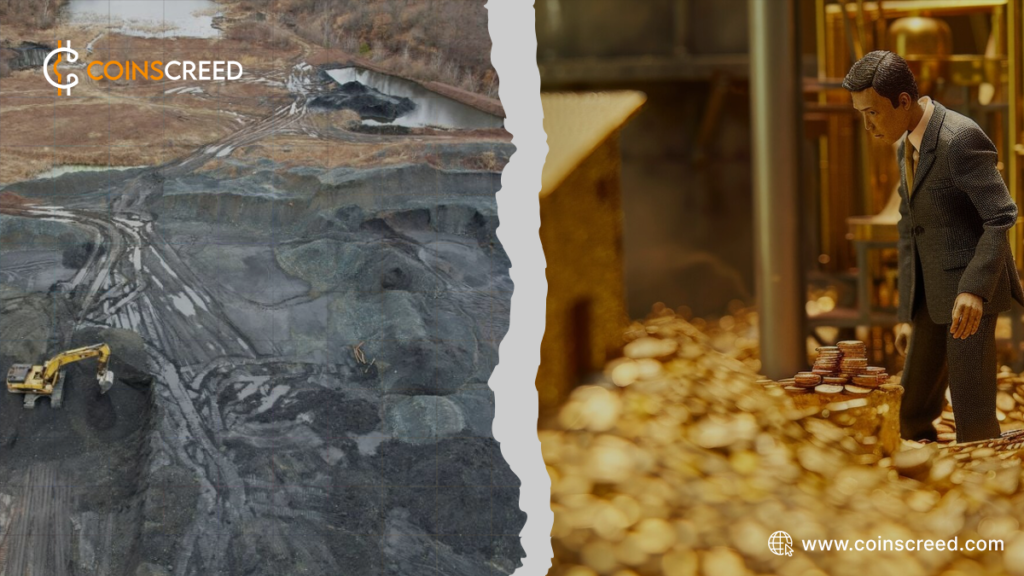Coin mining has emerged as one of the most exciting yet controversial activities in the world of cryptocurrencies. This process, which involves solving complex mathematical problems to verify and secure transactions on a blockchain, is often compared to a modern-day gold rush.

However, beneath the surface, a growing concern is the significant environmental impact of coin mining, particularly in terms of energy consumption and carbon footprint.
This article discusses both perspectives, providing an in-depth analysis of the benefits and environmental costs of coin mining.
A Digital Gold Rush
Cryptocurrency mining is akin to a modern-day gold rush. In traditional mining, individuals rush to mine valuable resources from the ground, such as gold, in the hopes of striking it rich. In the digital world, miners compete to “discover” new coins by solving cryptographic puzzles using computational power. The reward? Newly minted coins like Bitcoin or Ethereum, alongside transaction fees from validated transactions.
Coin mining serves two primary functions in cryptocurrency networks:
- Securing the Network
Miners validate transactions and add them to the blockchain ledger, ensuring that transactions are legitimate.
- Coin Creation
Mining introduces new coins into circulation, incentivizing miners to participate in the network.
These incentives have led to the rapid expansion of mining operations globally, with some miners setting up massive data centers dedicated solely to cryptocurrency mining.
The allure of potentially substantial financial rewards has led to significant interest from individuals and corporations, making it feel like a 21st-century gold rush.
Is Coin Mining an Environmental Hazard?
While the financial opportunities presented by coin mining are clear, its environmental impact has raised red flags. The mining process is energy-intensive, particularly in Proof-of-Work (PoW) systems, where miners require enormous computational power to solve cryptographic problems.
Here are some environmental issues associated with coin mining :
Energy Consumption
One of the biggest criticisms of cryptocurrency mining is the staggering amount of electricity it consumes. Bitcoin, for example, is notorious for its high energy demands. According to the Cambridge Bitcoin Electricity Consumption Index, Bitcoin mining uses more electricity than countries such as Argentina or the Netherlands.
Most mining operations take place in regions where electricity is cheap, often derived from coal or other fossil fuels, exacerbating their carbon footprint. A study from Nature Communications found that Bitcoin mining alone could push global temperatures beyond the 2°C limit set by the Paris Agreement if left unchecked. This has prompted debates about the long-term sustainability of current mining practices.
Carbon Emissions
In addition to high energy consumption, the carbon emissions generated by mining operations are a significant environmental concern. Mining facilities that rely on coal-powered energy, especially in regions like China and Kazakhstan, contribute heavily to carbon emissions. As a result, the environmental footprint of cryptocurrency mining is comparable to that of traditional industries, drawing sharp criticism from environmental advocates.
A report by Digiconomist estimated that the carbon footprint of Bitcoin mining was around 70 million metric tons annually, comparable to the emissions of countries like Greece or Austria. These emissions have raised concerns about the role of cryptocurrencies in global efforts to combat climate change.
E-waste
Beyond energy consumption and carbon emissions, mining also contributes to electronic waste (e-waste). The constant need for more powerful hardware, such as graphics processing units (GPUs) and application-specific integrated circuits (ASICs), results in the frequent replacement of outdated or less efficient mining equipment.
According to a 2021 report by Alex de Vries, Bitcoin mining produces around 30,700 tons of e-waste annually. The disposal of these electronic components poses serious environmental risks, as they contain toxic materials that can contaminate soil and water sources.
Efforts to Address Environmental Concerns
While coin mining’s environmental impact is undeniable, efforts are being made to mitigate the damage. Several approaches are being explored to make mining more sustainable. They include:
- Transition to Renewable Energy
Some mining operations are moving towards renewable energy sources, such as wind, solar, and hydropower, to reduce their carbon footprint. For instance, countries like Iceland and Norway, which have abundant geothermal and hydroelectric energy, have become popular hubs for cryptocurrency mining due to their low environmental impact.
Large mining companies are also investing in renewable energy solutions to power their operations. This shift could significantly reduce the industry’s environmental impact, especially as the demand for clean energy grows.
- Proof of Stake (PoS) Systems
A more radical solution to the environmental problem of coin mining is the adoption of Proof-of-Stake (PoS) consensus mechanisms. Unlike Proof-of-Work (PoW), which requires miners to solve energy-intensive puzzles, PoS relies on validators who lock up or “stake” their cryptocurrency to secure the network.
This system requires far less computational power and energy, making it a more sustainable alternative to PoW.
Ethereum, one of the largest cryptocurrencies, recently transitioned from PoW to PoS through its Ethereum 2.0 upgrade. This move is expected to reduce Ethereum’s energy consumption by over 99%, setting a precedent for other blockchain networks to follow.
- Regulatory Pressure
Governments and regulatory bodies worldwide are beginning to scrutinize the environmental impact of cryptocurrency mining. In some regions, such as China, authorities have taken steps to ban or restrict mining activities due to concerns over energy usage and environmental degradation. Other countries, like the United States, are considering carbon taxes or regulations that incentivize miners to adopt cleaner energy sources.
Conclusion
Coin mining represents both a modern gold rush and a significant environmental challenge. The allure of financial gain has driven the rapid expansion of the cryptocurrency mining industry, but its environmental footprint cannot be ignored. High energy consumption, carbon emissions, and e-waste have drawn sharp criticism, calling into question the sustainability of mining in its current form.
However, with the adoption of renewable energy sources, shifts to less energy-intensive consensus mechanisms like Proof-of-Stake, and increased regulatory oversight, there is hope that the industry can reduce its environmental impact. The future of coin mining may not lie in abandoning the practice altogether but in finding ways to make it more sustainable in the long term.

